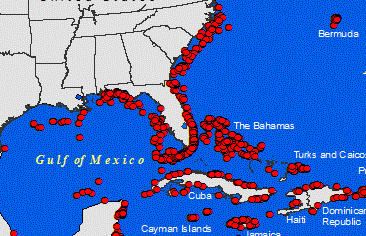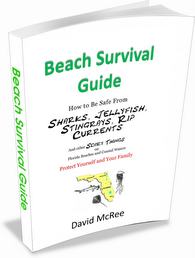Exotic lionfish have invaded Florida waters. They are a problem because:
- They eat everything in sight and can reduce reef fish populations by 80% in a matter of weeks.
- They have poisonous spines and are dangerous to humans, especially to divers and fishermen.
- They have no natural predators to keep their populations in check.
- They can reproduce every 4 days.
- They are resistant to parasites that affect native fish.
According to a CNN video on lionfish, the first sightings in Florida were off the southeast coast in 1985. It wasn’t until 2000 that there seemed to be a major lionfish population explosion up the Florida Atlantic coast.
By 2004 they were sighted in the Bahamas, and by 2007 they were everywhere, including the Gulf of Mexico.
Click on the image map below to see a chilling animated graphic showing the explosion of the lionfish populations between 1986 and 2011:
(After viewing the animation use your browser’s “back” feature to return to this page)
It is believed that the lionfish was introduced to Florida waters by aquarium hobbyists who released them into local waters. These fish are native to the Pacific Ocean where they have natural predators to keep their populations under control.
They don’t belong in Florida.
Solutions to the Problem of Lionfish in Florida
Treating Lionfish Sting Injuries
Being stung by the long, thin, needle-sharp spines of even a small lionfish generally results in a fire-like pain which is often localized to the area stung, but may travel along the extremity. Expect swelling. Needless to say, a sting to the head, neck or body cavity is more serious and should be considered a medical emergency. It is possible that a portion of the spine may break off in the wound, requiring surgical intervention. Infection is always a possibility. A host of other symptoms and complications are possible.
First-aid for a lionfish sting (before you can get to a doctor) mainly consists of applying heat, which destroys the venom. The problem is, where are you going to get heat if you are out on a boat or standing on a dock?
Ocean Care Solutions has developed a lionfish sting first-aid kit that has what you need. It should be available around mid-January 2013 and will retail for around $20. The supplies contained in the kit are based on treatment protocols with scientific and medical support and derive from medical data and injury reports.

What’s in the OCS Lionfish Sting First-Aid Kit?
- Moist towelette for cleaning hands
- Latex-free gloves
- Gauze pad to help slow bleeding
- Sterile saline solution for rinsing wound
- Forceps / tweezers to remove spines
- Instant Heat Pack to alleviate pain
- Elastic wrap for holding heat pack in place
- Ocean Care Solutions triple antibiotic ointment
- Adhesive bandages
Ocean Care Solutions is a pioneer in the development of effective, convenient and affordable first-aid kits for marine sting injuries, including for jellyfish, stingrays, sea urchins, fire-coral, and Portuguese Man-of-War.
Ocean Care Solutions’ products were nominated for the 2012 World Open Water Swimming Offering of the Year.
Below are the instructions as shown on the back of the foil packet which houses the kit. Click on the image below to enlarge it enough to read:
Reducing Lionfish Populations
Faced with a dramatic reduction of native populations of fish–which support fishing and diving recreational tourism–nearly everyone is working to reduce the lionfish populations. From spearfishing to hook and lining, any method to get them out of the water is seen as a step in the right direction. Citizen organizations like LionFishHunters and The Lionfish PSA have sprung up to educate the public and direct us toward steps necessary to control this opportunistic species.
Especially in the Florida Keys, locals are trying hard to put lionfish on the menu in seafood restaurants, hoping we can eat them into submission. Lionfish is reported to have an excellent taste and is often compared to hogfish or snapper. It’s not dangerous to eat because the poison is only contained in the spines. The meat is safe to eat.
Want to know how to clean and cook a lionfish? Here’s a great 4 minute video to show you how:
For a very well produced video by CNN on the lionfish problem, check out the 7 minute video below:
Below are some additional links to information about the Florida lionfish “invasion.”
Reef.org – Report a lionfish sighting and learn more about the whole lionfish thing, including links to some restaurants that have lionfish on the menu.
Mote Tropical Research Lab lionfish info. An excellent web site with a lot of information and links to other resources.





